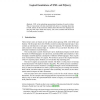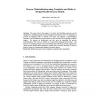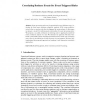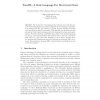RWEB
2009
Springer
14 years 6 months ago
2009
Springer
XML is the underlying representation formalism of much web-data. Thus to reason about web-data essentially boils down to reasoning about data in XML format. In this course the stud...
RWEB
2009
Springer
14 years 6 months ago
2009
Springer
RWEB
2009
Springer
14 years 6 months ago
2009
Springer
In this chapter we will introduce description logics, a family of logic-based knowledge representation languages that can be used to represent the terminological knowledge of an a...
RWEB
2009
Springer
14 years 6 months ago
2009
Springer
RULEML
2009
Springer
14 years 6 months ago
2009
Springer
The main idea in this paper is to show how flexible processes can be designed by combining generic process templates and business rules. We instantiate a process by applying rules ...
RULEML
2009
Springer
14 years 6 months ago
2009
Springer
Abstract. In this paper, a novel architecture for high-level scene interpretation is introduced, which is based on the generation of rules from an OWL-DL ontology. It is shown that...
RULEML
2009
Springer
14 years 6 months ago
2009
Springer
Rule bases are increasingly being used as repositories of knowledge content on the Semantic Web. As the size and complexity of these rule bases s, developers and end users need met...
RULEML
2009
Springer
14 years 6 months ago
2009
Springer
RULEML
2009
Springer
14 years 6 months ago
2009
Springer
Abstract. Event processing rules may be prescribed in many different ways, including by finite state machines, graphical methods, ECA (event-conditionaction) rules or reactive rule...
RULEML
2009
Springer
14 years 6 months ago
2009
Springer
Abstract. We present the Tom language that extends Java with the purpose of providing high level constructs inspired by the rewriting community. Tom bridges thus the gap between a ...




